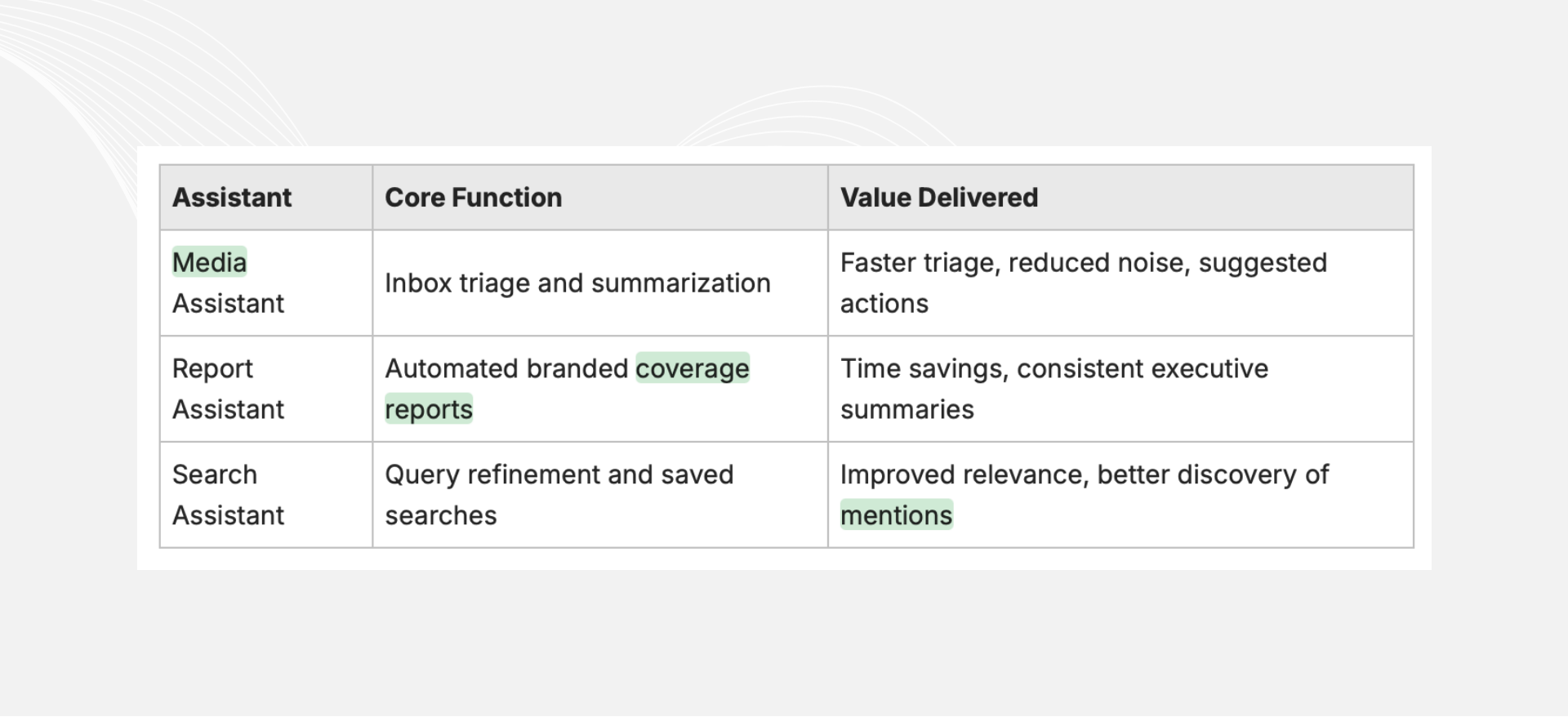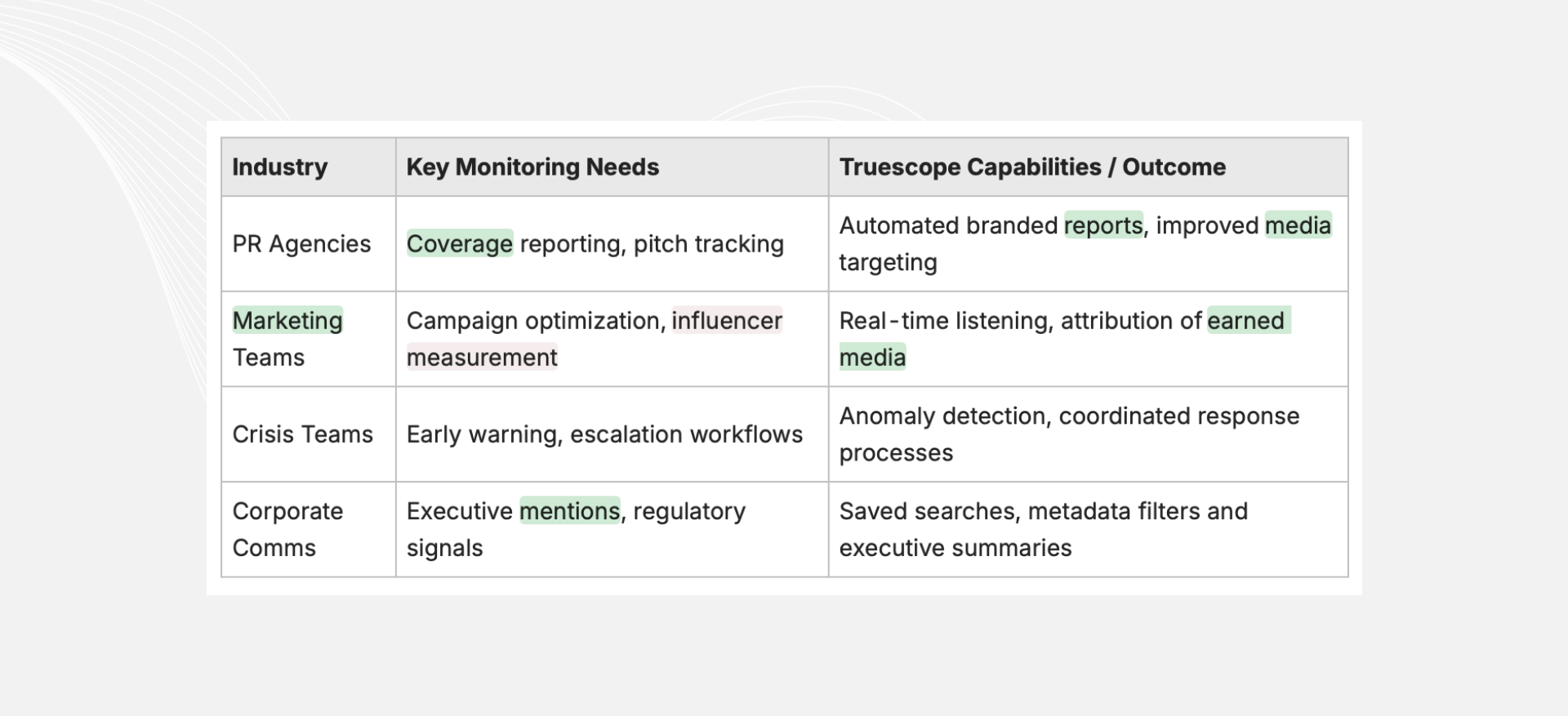Social Listening Tools by Truescope: How AI Enhances Brand Monitoring and Online Reputation Management


Media monitoring and social listening combine continuous tracking of public information with interpretation of what audiences say and feel about a brand, product, or issue. This article explains how media monitoring services and social media monitoring services collect and analyze mentions across news, broadcast, blogs, podcasts, video, and social platforms to deliver actionable AI-driven media insights. Organizations face three core problems: overwhelming volume, fragmented channels, and slow manual analysis; generative AI and unified media intelligence platforms address these by automating triage, summarization, and search. Truescope is an AI-first unified media monitoring and social listening platform with generative AI assistants — Media Assistant, Report Assistant, and Search Assistant — that illustrate how automation converts coverage into fast, relevant insight. Below we define monitoring versus listening, map architecture and coverage sources, explain Truescope’s assistant workflows, outline core features and EAV comparisons, provide industry-specific use cases and practical steps for reputation management, and discuss future AI and privacy considerations. Readers will gain a practical playbook to implement real-time brand sentiment tracking, crisis detection, competitor intelligence, and automated reporting using modern AI-enhanced media monitoring software.
What Is Media Monitoring and Social Listening? Definitions and Key Differences
Media monitoring is the systematic collection and tracking of public mentions across traditional and digital media to quantify exposure and reach, while social listening interprets social-native signals to surface sentiment, trends, and intent. Monitoring works by ingesting structured feeds, transcripts, and published content to measure mentions, impressions, and reach; listening analyzes posts, comments, and engagement to extract topics, influencers, and emerging narratives. The result is complementary: monitoring answers "where and how much" coverage existed and listening answers "what audiences think and why." Understanding both approaches gives PR and marketing teams a combined toolkit to measure share of voice, track campaign impact, and detect early warning signals. The next sections explain how monitoring captures different media types and how listening derives consumer insights to inform actions.
How Does Media Monitoring Track Traditional and Digital Media?
Media monitoring captures print, broadcast, online news, podcasts, and video by combining structured feeds, APIs, transcription/OCR, and broadcast capture workflows that convert audio and image content into searchable text. In practice, ingestion pipelines include newswire feeds for online articles, broadcast transcription for TV and radio, OCR for scanned print coverage, and metadata extraction for podcasts and video, which yields mention counts, estimated reach, and publication authority. Metrics commonly tracked include mention frequency, reach/impressions, placement (headline, body), and tonality or sentiment, which feed dashboards for trend and share-of-voice calculations. These technical ingestion steps enable teams to quantify coverage across formats and move from raw data to prioritized alerts for stakeholders, which sets up why social listening adds contextual audience signals.
What Is Social Listening and How Does It Capture Consumer Insights?

Social listening captures platform-native signals such as posts, replies, hashtags, shares, and reactions to reveal sentiment dynamics, topical clusters, and influencer activity using Natural Language Processing and engagement metrics. Listening pipelines focus on conversational volume, sentiment trends, virality signals, and author metadata to surface trending topics, community sentiment shifts, and potential influencers or detractors. Multilingual processing and platform-specific parsers ensure that insights span regional markets and medium differences, while topic modeling clusters conversations for campaign optimization and product feedback. These outputs allow teams to translate social signals into operational actions like content amplification, influencer outreach, or rapid message adjustments.
The effectiveness of social listening in understanding consumer sentiment is significantly enhanced by advanced AI techniques.
AI-Driven Sentiment Analysis for Social Media Brand MonitoringSocial media serves as the primary channel for digital communication with target audiences, enabling interaction with diverse consumer groups through tailored marketing strategies. The inherent human need for social orientation and interaction, amplified by digitalization, has significantly boosted the popularity of various social media platforms. Each platform possesses distinct characteristics that necessitate specialized thematic content and specific subscriber interactions. During engagement with companies and brand discussions, users employ text messages, stylized graphical elements (emoticons, emojis, memojis, animojis, etc.), as well as photographic and video content. Optimizing a company's marketing strategy requires comprehensive research into the target audience and the identification of user responses to various brand initiatives.
AI-driven sentiment analysis in social media content, I Ponomarenko, 2024
Why Are Media Monitoring and Social Listening Essential for Brand Monitoring?
Media monitoring and social listening are essential because they link public exposure to audience perception, enabling reputation protection, campaign measurement, and competitive insight through continuous observation and informed intervention. Early warning systems detect abnormal mention spikes or sentiment deterioration, allowing for faster escalation and mitigation, while combined monitoring/listening supports measurement of campaign ROI and earned media attribution. For PR, marketing, and customer care, this combined capability reduces missed mentions and improves prioritization of outreach and responses. These practical business benefits make integrated media intelligence a cornerstone of proactive brand monitoring and crisis preparedness.
Effective online reputation management relies on a deep understanding of how public perception is shaped and how to actively influence it.
Online Reputation Management: Strategies for Virtual and Physical Environments
Advancements in communication and information technologies have compelled organizations to recognize the significance of their reputation in both the digital and physical realms. Organizations with a strong reputation are more appealing to investors and customers. Concurrently, organizations possessing a robust corporate reputation navigate crises more effectively. Reputation management is a core function within public relations practices. A primary objective of public relations is to cultivate and sustain positive relationships between organizations and their stakeholders, thereby developing and preserving a strong reputation in both the physical and virtual worlds. This paper elucidates the definitions of corporate reputation, online reputation, and online reputation management, along with their importance in customer relations, communication, and public relations. This study endeavors to define the constituent elements that establish, foster, and uphold a robust reputation within the...
A review on online reputation management and online reputation components, N Şirzad, 2022
How Does Truescope Use AI to Transform Media Monitoring and Social Listening?

Truescope applies generative AI and machine learning across ingestion, triage, summarization, and search workflows to reduce manual effort and surface precise, actionable insights. The platform’s assistants — Media Assistant, Report Assistant, and Search Assistant — automate inbox triage, produce branded summaries, and refine saved searches to improve relevance, which accelerates response and reporting cycles. AI-driven sentiment analysis and summarization condense large coverage volumes into executive summaries and highlight quotes and recommended actions, saving time for PR and comms teams. The section below details each assistant, clarifies sentiment and summarization benefits, and explains how report and search automation change day-to-day workflows.
What Is Generative AI and How Does It Power Truescope’s Media Assistant?
Generative AI refers to models that synthesize human-readable content from data inputs; in media monitoring, it powers automated summaries, suggested actions, and conversational triage for incoming mentions. Truescope’s Media Assistant uses generative models to triage an AI-powered media inbox, summarize clusters of related mentions, and propose follow-ups or escalation steps so teams can focus on context and decisions rather than sifting coverage. This assistant reduces noise by grouping duplicates and surfacing representative items with concise summaries and suggested priority, enabling faster decision-making and clearer workflows. The time saved in initial triage translates to quicker responses for emerging issues and more strategic allocation of team capacity.
How Do AI-Driven Sentiment Analysis and Summarization Improve Media Insights?
AI-driven sentiment analysis adds nuance beyond binary positive/negative labels by detecting tone, sarcasm, and emotion, while summarization condenses volume into digestible narratives that highlight key quotes, trends, and context. Improved sentiment models incorporate contextual signals and multilingual understanding to reduce false positives and capture shifts in brand health across channels. Summarization automates executive summaries and talking points for stakeholder briefings, meaning teams can distribute actionable narratives without manual synthesis. Together these capabilities speed insight extraction and make media intelligence directly usable for decision-makers and cross-functional teams.
The sophisticated understanding of language nuances provided by models like BERT is crucial for accurate sentiment analysis in brand monitoring.
Report Assistant automates branded coverage reports with AI-generated executive summaries, while Search Assistant improves discovery by refining queries and suggesting saved searches for recurring needs. Report Assistant compiles selected mentions, metrics, and narrative summaries into stakeholder-ready formats, reducing hours of manual report-building to minutes and standardizing outputs for consistent measurement. Search Assistant augments saved searches by improving query relevance, surface similar mentions, and recommending filters, which increases recall and precision in ongoing monitoring tasks. These assistants convert raw data into repeatable, operational outputs that support faster decisions and clearer stakeholder communication.

What Are the Core Features of Truescope’s Media Monitoring Software?
Core features of modern media monitoring software include real-time alerts, cross-channel coverage, customizable dashboards, and competitor intelligence; Truescope implements each with unified indexing, AI summaries, and flexible notifications. Real-time alerts are configurable by severity and keywords and can route to communication channels so teams respond faster. Cross-channel coverage unifies print, broadcast, online, and social mentions into a single index with deduplication and metadata to present a single source of truth. Dashboards provide customizable KPI widgets, scheduled automated reports, and export formats with AI-generated executive summaries to share with stakeholders.
How Do Real-Time Alerts and Notifications Enhance Brand Monitoring?
Real-time alerts notify teams of important events by severity, keyword triggers, or sudden volume changes, enabling immediate investigation and action to contain issues or capitalize on opportunities. Truescope’s alert logic supports priority routing and integrations with common workflows so alerts reach the right people in seconds, and threshold configurations reduce false positives. Example scenarios include detecting a sudden influencer spike, an emerging crisis in a regional market, or a high-authority article placement requiring outreach. Faster time-to-response preserves reputation and reduces the window for misinformation to spread.
How Does Truescope Provide Comprehensive Coverage Across Traditional and Social Media?
Comprehensive coverage combines indexed sources across news sites, broadcast transcripts, podcasts, blogs, forums, and social platforms with methods such as API ingestion, transcription, and OCR to surface mentions across formats. Unified indexing includes de-duplication and metadata like author, publication, and estimated reach so teams see consolidated mention counts and context for each item. This unified view prevents tool-switching and enables cross-channel trend analysis, which improves strategic decisions like message adjustments and cross-platform amplification. The ability to correlate online conversations with traditional media coverage helps teams measure ecosystem-level impact.
What Customizable Dashboards and Automated Reporting Options Are Available?
Custom dashboards let users add KPI widgets for sentiment, share of voice, top mentions, and influencer activity and export views for executives or campaign owners with scheduled reporting cadence. Truescope supports templates and stakeholder-specific views that include AI-generated summaries and downloadable formats for distribution, while scheduled reports can be tailored daily, weekly, or monthly. Recommended KPIs include mention volume, net sentiment, top publications, and campaign-attributed earned media; these dashboards make insights shareable and actionable. The next subsection explains how competitor intelligence complements these reporting capabilities.
How Does Competitor Intelligence Support Market Analysis?
Competitor intelligence tracks share of voice, mention trends, and benchmarking metrics to reveal relative performance and strategic moves across the market landscape. Using indexed mentions and trend comparisons, teams can detect competitor campaign spikes, crisis events, or shifts in messaging and adjust their own tactics accordingly. Alerts for competitor activity provide early signals that inform PR outreach, product positioning, and strategic communications. Combined with dashboard benchmarking, competitor intelligence enables evidence-based decisions about messaging, spend, and response strategies.
What Crisis Communication Tools Does Truescope Offer?
Crisis tools include early warning detection, escalation workflows, stakeholder notification templates, and post-crisis analysis to measure sentiment recovery and impact. Early warning uses threshold-based alerts and anomaly detection to flag fast-moving issues, while escalation workflows assign owners and route communications to response teams. Post-crisis analysis consolidates timeline, sentiment trajectory, and media reach to inform post-mortem learning and reset monitoring rules. These capabilities support the full crisis lifecycle from detection to response and recovery, which reduces reputational impact and shortens resolution time.

How Can Businesses Use Truescope for Effective Brand Reputation and Online Reputation Management?
Businesses use media monitoring and social listening to track mentions, measure sentiment, and operationalize insights into PR and customer care workflows that protect and grow brand reputation. A practical four-step workflow includes ingestion and tagging, automatic sentiment classification, alerting and escalation, and reporting with recommended actions for stakeholders. By integrating mention metadata—reach, author, location—and saved searches, teams can detect emerging issues, prioritize high-impact items, and route tasks to PR or customer service for resolution. Below we detail mention analysis, the role of sentiment as a KPI, and tactical uses for PR and marketing teams.
What Role Does Sentiment Analysis Play in Brand Health Monitoring?
Sentiment analysis functions as a directional KPI that signals shifts in public perception, but it requires calibration and human-in-the-loop checks to account for nuance and regional language differences. Teams should treat sentiment as an early indicator rather than a definitive verdict and pair it with qualitative review of representative mentions and quotes. Calibrated sentiment enables dashboard thresholds and alert rules that reduce noise while highlighting substantive changes. Using sentiment trends alongside volume and reach provides a fuller picture of brand health and campaign effects.
How Can PR and Marketing Teams Leverage Truescope’s Insights?
PR and marketing teams can use monitoring outputs for media list creation, pitch effectiveness analysis, campaign optimization, influencer selection, and earned media attribution by translating mention-level data into tactical actions. For PR, automated coverage reports and tracked press lists streamline client reporting and measure coverage ROI; for marketing, listening insights inform creative adjustments and channel targeting during live campaigns. Cross-team collaboration benefits from shared dashboards and scheduled AI-generated reports that align stakeholders on priorities and evidence-based next steps.
Truescope-supported steps for operationalizing insights: Ingest & Tag: Aggregate mentions and apply topic, campaign, and sentiment tags.Alert & Triage: Route high-severity items to response owners via alerts.Analyze & Summarize: Use AI summaries to create stakeholder-ready narratives.Report & Iterate: Schedule automated reports and refine saved searches based on outcomes.
What Are the Industry-Specific Use Cases for Truescope’s Media Monitoring and Social Listening?
Different industries have distinct monitoring needs; Truescope’s unified platform can be configured to prioritize the signals and outcomes most relevant to PR agencies, marketing teams, and crisis management functions. For PR agencies, the emphasis is on faster coverage reporting and pitch effectiveness; for marketers, the focus centers on campaign optimization and influencer measurement; for crisis teams, the priority is early warning and coordinated response. The EAV table below maps industries to monitoring needs and Truescope capabilities to show expected outcomes and measurable benefits.
How Do PR Agencies Benefit from Truescope’s AI-Powered Media Intelligence?
PR agencies gain efficiency through automated coverage reports, improved media lists, and faster pitch tracking, enabling more client-facing time and clearer ROI measurement. AI summaries reduce manual time spent compiling coverage and allow teams to deliver consistent, branded reports with recommended talking points. Media contact effectiveness insights help refine targeting and yield better placement rates, while time savings enable agencies to scale services without proportional headcount increases. These efficiencies improve reporting cadence and client satisfaction.
How Is Crisis Management Enhanced Through Early Warning and Response Monitoring?
Crisis management benefits from configured early warning signals, escalation playbooks, and coordinated notification workflows that reduce time to respond and limit reputational damage. Signal indicators include sudden volume spikes, rapid sentiment deterioration, and high-authority negative placements; escalation protocols assign owners and trigger prepared messaging templates. Post-crisis analysis then measures sentiment recovery and reach to inform future preparedness and change monitoring rules. This closed-loop approach shortens incident lifecycle and improves cross-functional coordination.

Why Choose Truescope Over Other Media Monitoring and Social Listening Tools?
Choosing a monitoring solution hinges on three differentiators: AI-first assistants that automate narrative workflows, unified cross-channel coverage that prevents tool switching, and operational efficiencies that speed reporting and response. Truescope’s assistant-centric approach shifts work from manual synthesis to AI-assisted prioritization and narrative generation. A unified platform consolidates print, broadcast, online, and social data into one indexed view, reducing missed mentions and simplifying benchmarking. Operational benefits include faster report generation, prioritized alerts, and consistent stakeholder-ready summaries, which together improve media engagement and resource allocation.
What Do Customer Success Stories Reveal About Truescope’s Impact?
Customer feedback typically highlights measurable outcomes such as time saved in reporting, improved sentiment tracking, and clearer coverage ROI when platforms provide standardized summaries and automated reports. While specific client metrics should be presented with anonymization and permission, typical template outcomes include reduced reporting time, faster escalation, and improved media engagement metrics that validate platform adoption. Organizations are advised to collect and publish anonymized case-study metrics to demonstrate impact credibly and help prospective users set realistic expectations when evaluating solutions.
Key differentiators to consider when evaluating providers: Assistant Workflows: Does the platform produce narrative summaries and suggested actions?Unified Coverage: Are traditional and social sources indexed together with de-duplication?Operational Outputs: Can you generate scheduled branded reports and integrate alerts into workflows?
How Does Truescope Address Data Privacy and Compliance in Media Monitoring?
Privacy and compliance are fundamental considerations for media monitoring, with frameworks like GDPR and CCPA shaping data governance, anonymization, and consent practices for collected data. Best practices include minimizing personal data retention, applying anonymization where appropriate, maintaining clear processing records, and offering transparent documentation on data handling policies. Teams should link monitoring configurations to compliance needs, limit sensitive data capture, and implement human review for flagged items that may contain personal data. Providing clear compliance documentation and governance processes builds trust and reduces legal risk as monitoring scales.
Privacy and compliance checklist for monitoring programs: Assess data types collected and map to regulatory obligations.Minimize personal data capture and implement anonymization where possible.Document processing activities and retention policies.Review AI outputs with human oversight for sensitive cases.





